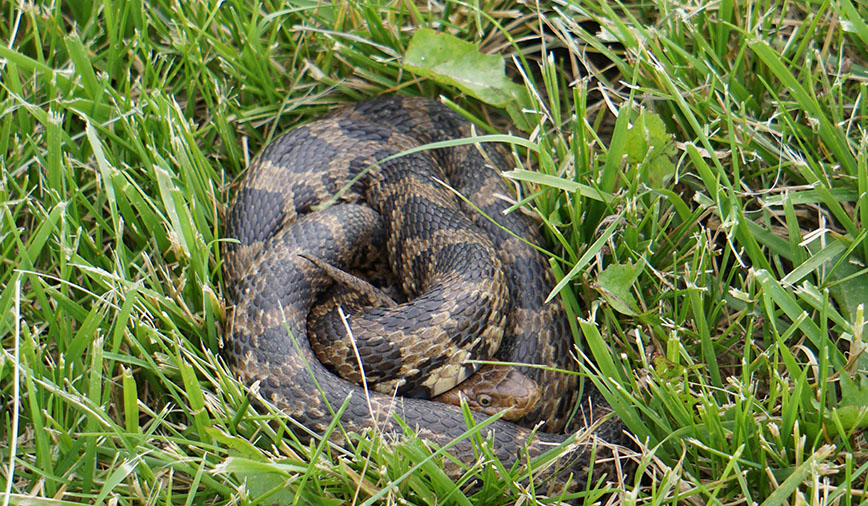July 11, 2014
No rattles, fangs or venom: This snake’s round pupil helps identify it as a nonvenomous western fox snake, Pantherophis vulpinus, a species that is locally common in areas throughout Kane County.
Fox Snake
I think it’s safe to say, most people in our area can recognize a garter snake.
Smallish to medium in size, dark in color with a prominent, greenish-yellow or orangish-yellow (depending on species) stripe running down the middle of the back… These are the critters sometimes referred to as “garden” snakes and, even though they don’t seem as prevalent as they once were, are still considered common throughout Kane County.
So it is, then, when most folks spot Thamnophis in the field they tend to refer to it as “just” a garter. Even a person with bona fide ophidiophobia usually can quell their fears and forge ahead knowing that the snake they glimpsed was small and harmless. (We’ll just leave the topic of garters’ toxic secretions to another time…)
But I’ll wager that the majority of people in Kane County cannot accurately identify our area’s other common slithery reptile: the western fox snake, Pantherophis vulpinus.
Averaging about four feet in length, adult fox snakes are larger than garters. Their yellowish-tan bodies are marked with dark brown splotches, anywhere from 32-52, with an average of 41, evenly spaced along the back and alternating with smaller brown spots along each side of the body.
It’s the sort of pattern and color combination that, for better or worse, makes people think, “Yow! Rattlesnake!”
I’ve gotten calls from people who have abandoned their plans for a peaceful nature walk due to a “rattler” sunning itself on a trail. I’ve talked with folks who have dispatched “rattlers” with hoes and shovels. I’ve seen first-hand the hacked
up remains of a “rattler” slopped inside of a shoebox and brought in for positive identification—a classic though somewhat disturbing case of “whack first, ask questions later.”
But, here’s the thing: Fox snakes are not rattlesnakes. While they may bear a superficial resemblance, their heads are not triangular in shape. They do not have heat-sensing “pits” between their eyes and nostrils. Their pupils are round, not vertical slits.
It’s true, they shake their tails when agitated. But their tails lack rattles.
Perhaps most important, fox snakes possess neither fangs nor venom. (Which is not to say that fangs and venom are bad. But, like toxic secretions, we’ll defer discussion of these remarkable adaptations to another time.)
Fox snakes are constrictors, which means that, like their distant and perhaps more famous cousins the boas, they squeeze their prey prior to swallowing.
Diurnal hunters, they can be found in open fields as well as edge habitats, where grassy areas border woodlands. These places are home to a wide variety of small mammals, including mice, voles and ground squirrels.
To put it in perspective, a fox snake’s territory usually is smack-dab in the center of an all-you can eat buffet. But instead of steam-table pans of pastas, potatoes, veggies and meats, P. vulpinus eats its fill of rodents—animals that, if left unchecked, could quickly overpopulate and cause all kinds of problems for the other animals in their ecosystem, including humans.
I remember one time getting a call from a woman who was, shall we say, less than thrilled to have found a young fox snake coiled up underneath a toy in her child’s sandbox. She was, at first, even more dismayed to learn that young animals like that are a sign that reproduction has occurred, and that somewhere close by there likely was a momma, a poppa and other little sibling fox snakes.
As we talked further though, she detailed the troubles her family had had with marauding mice living in an ancient woodpile at the back of her yard. Eventually, she began to see that the young fox snake—rather than being a sign of another problem—was actually an indication of an effective and highly efficient solution. Just as adult fox snakes eat adult mice, baby fox snakes eat baby mice—and lots of ’em.
By the time we hung up, the woman was, if not entirely pro-snake, at least less anti-snake than she was when she called. Best of all, she agreed to leave the snake to its own devices, minus the sandbox-toy hiding places, which she vowed to lock up in a storage bin.
Earlier this week, I had the good fortune to encounter a fox snake enjoying its own version of all-you-can-eat—a young thirteen-lined ground squirrel that clearly had been caught unawares alongside a mowed path in a large, grassy field. The snake had its jaws wide open; not “unhinged,” as it is sometimes described, but spread to 150° as the extra bones at the back of the jaw extended.
To help move the meal along, the snake made use of its unique lower jaws. Unlike human jaws, which are fused together at the chin, snakes’ lower jaws are separate. They can be moved independently, millimeters at a time, to slowly “walk” the prey down the animal’s throat.
So engaged, the snake at that moment was as vulnerable as the prey it was engulfing. I couldn’t help but wonder, what would happen if a hawk swooped down, or a coyote pounced?
I didn’t have to speculate for long. The wild snake, clearly accustomed to dining and dashing (slurping and slithering?) in a matter of minutes finished its big snack and then quickly disappeared back into the tall grass.
No rattles, no fangs, no venom, just 100% fox snake, doing what it’s meant to do.
Yow! How cool is that?
Pam Otto is the manager of nature programs and interpretive services at the Hickory Knolls Discovery Center, a facility of the St. Charles Park District. She can be reached at 630-513-4346 or potto@stcparks.org.

